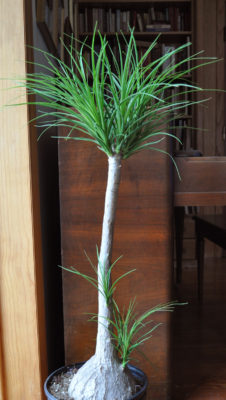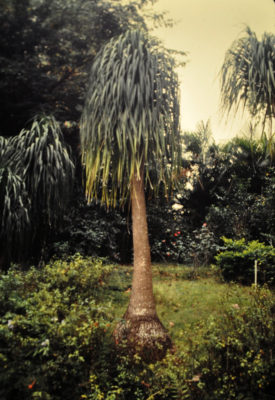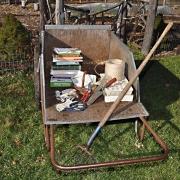MY PONYTAIL GROWS, AND SEEDS ENTICE
I Grow A Ponytail
A friend gave me a ponytail palm (Beaucarnea recurvata) decades ago, and up to this summer it looked something like a palm tree sitting atop a large onion. Or a long-leafed dracena plant whose stem, near ground level, had swollen almost to the size of a bowling ball. The plant looked very interesting, but not particularly attractive, and the sharp edges of its long, strappy leaves were grabbing at me every time I walked by too closely.
So last summer, I was going to toss the plant in the compost pile; instead, I lopped off its top to about 3 feet in height. What remained was nothing more than what looked like a tan bowling ball halfway immersed in a pot of soil with a inch-thick, bare stem tapering skyward from its upper side.
After pruning, I ignored the plant just as I had done for the past few decades. Ponytail palm doesn’t crave attention. As testimonial to the ability of the bulbous trunk to store water, the plant went months between waterings. What’s more, it’s been growing in the same pot with the same potting soil for all these years, no small accomplishment with the bulbous base of the plant, rather than potting soil, occupying much of volume within the pot. And fertilization? A rare event.
Now for the good part: Since being decapitated, the ponytail palm has sprouted tufts of leaves in various places. A few new sprouts appeared near the top of the plant, just as most plants would do when the top bud or portion of a stem is cut back. A tuft also appeared lower down along the stem. And seemingly out of nowhere, a couple of tufts of leaves sprung from the rounded surface of the swollen bulb.
Over time, each of those tufts of leaves is going to elongate into a stem capped by a tuft of leaves.
The plant is more verdant and very attractive now, and I should be able to direct its growth to remain so. If not, I can lop back one or more ponytails and start again.
Ponytail, Down The Road
Ponytail palm is quite a dramatic site in its native, tropical haunts. There, the plant’s stem keeps elongating, lifting its mophead of scrappy leaves higher and higher. Tufts of leaves might sprout lower down along the stem, or from the base, just as did my decapitated plant. And the bulbous base — it keeps growing fatter and fatter.

Ponytail palm in Puerto Rico
In Puerto Rico, I’ve seen ponytail palms the were three feet across as ground level. My plant will get a new pot as soon as it bursts out of its old one. But eventually . . . ?
Seeds! Restrain Me
Years ago, the routine was that seed catalogues would arrive in the mail sometime after January and all of us gardeners would place our orders to receive seeds a couple of months later. Now, I have catalogs that have already been sitting on my kitchen table for a few weeks, with orders waiting to be finalized. And not primitively finalized, with pen and paper, but seamlessly, on the internet.
Seed companies realized that the early bird gets the worm: We gardeners, once cold weather has set in, are likely to get seduced by any reference to fresh tomatoes, so are most likely to order from the first catalogs we see. All this is for the better, for me, at least, because my efforts to limit down time in the garden mean that I need to have seeds in hand and ready to sow that much sooner. I could sow lettuce seeds today, for harvest in the greenhouse. Onion and leek seeds get sown in seed flats at the beginning of February, lettuce for transplants to be planted outdoors, follows soon after that, along with pansies and snapdragons, and the march continues from then on right through September.
One thing that has not changed over the years is that I’m still enticed and thankful for what we gardeners have at our fingertips. From just a phone call, a few dollars, or a few computer keystrokes, plants from all over the world end up in my garden. How can I resist trying Ruby Mist Love Grass, Cajun Jewel Okra, and Blazing Stars this year, along with such old standbys as Buttercrunch lettuce, Blue Lake beans, and Lemon Gem marigolds?




I always enjoy hearing about your farm/garden, Lee. I would find it very helpful if you would include which seed/plant source you use when you refer to some favorites you order. Like your friend, Margaret Roach always says, ” a brandywine is not a brandywine is not a brandywine”. From who do you order your Buttercrunch lettuce and Blue Lake beans? I garden in Highland Park, Illinois, only a few blocks away from cool Lake Michigan.
I’ll try to remember sources. Most of the vegetable seeds I purchase from Fedcoseeds.com; additionally from Johnysseeds, Tomato Growers Supply Co., Totally Tomatoes, and Sustainable Seed Co. I make a lot of my own fruit plants, but when purchasing them, go to Raintreenursery.com and cumminsnursery.com, except for blueberries, which I always buy from Hartmannsplantcompany.com.
I just finished watching an old episode of Victorian Kitchen Garden in which they compared a seed catalog from the 1880s to one from the 1980s. The number of varieties offered in Victorian times was truly impressive. I’m thrilled that we are moving back in that direction, even a little.
My ponytail plant is 50 years old but tall and thin what can I do to thiken it. It”s leaves are also droopy.
Perhaps more light in summer. Mine gets 6+ hours of direct summer sun.